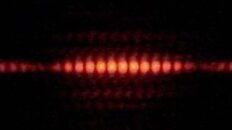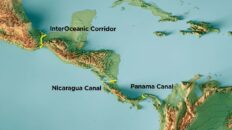There’s an area of space called the South Atlantic Anomaly, or the SAA, where the Earth’s magnetic field is significantly weaker, allowing solar and cosmic radiation dangerously close to the atmosphere. From the beginning of the space age, it has caused issues with satellites and astronauts as they passed through it, with some satellites actually being destroyed because of it.
But… why is it there? What causes it? And should we be concerned about it?
TRANSCRIPT:
Humans have known about the geomagnetic field for at least 2400 years with compasses and navigational equipment. But it was only mapped for the first time in 1701, by Sir Edmond Halley, the comet guy.Humans have known about the geomagnetic field for at least 2400 years with compasses and navigational equipment. But it was only mapped for the first time in 1701, by Sir Edmond Halley, the comet guy.
To make his map, Halley sailed the Atlantic for nearly 2 years and collected observations at 170 locations
Scientists these days make maps using complex instruments on the ground and in space, but they have to be careful about those space based observations
Because there’s one region of the Earth’s magnetic field that’s particularly dangerous to pass over. It’s this one spot where the field is particularly weak and has had consequences for satellites from the beginning of the space age. It’s known as the South Atlantic Anomaly.
A REGION OF FLUX
The oldest detection of the South Atlantic Anomaly — or SAA — I could find is from August 1960
A team of scientists at the Lebedev Institute of Physics, Moscow noted “intense charged particle flux” at 300 kilometers over the southern Atlantic Ocean
The satellite that registered the flux counted 100 times more particle collisions than in regions outside
300 kilometers is much closer to Earth’s surface than most of the inner Van Allen Belt – The altitude of the belt varies, but it typically goes no lower than 600 kmWhy is the SAA an exception?
It’s because for some reason the field strength right here is weaker, bottoming out around 22,000 nanoteslas, which is about half the typical strength at that latitude
Weaker geomagnetism means high-energy particles can get closer to Earth before they’re deflected by the magnetic field
A weak field means a lower Van Allen Belt, and more energetic particles
Since it was first detected in 1960, the belt has been detected as low as 200 km
You might be wondering if this spot is more dangerous for humans and, yeah, it is. Thankfully few humans need to go there – more on that in a second
SINGLE EVENT UPSETS
What does need to go there are satellites – and this is a problem.
Communication and scientific satellites can be affected in this region, most commonly by Single Event Upsets, or SEUs.
This is when an energetic particle interacts with a satellite’s computer, which can cause a discharge in computer memory
For us non-computer scientists, that means a small amount of information stored in the computer is lost
To get slightly in the weeds for a second, computers store information as bits — ones and zeroes
These bits are combined to represent documents, videos, and anything else stored on the computer
In a satellite, a bit might be part of instructions for how to relay a TV signal or how to burn fuel to stay at the right height
So you can see why losing part of that information would cause problems, not just in keeping it from operating correctly but just staying in orbit.
But this is a known problem, so some manufacturers add shielding to protect against SEUs, but this can get expensive, and adds weight.
BACKUPS AND OTHER STRATEGIES
So more often than not, satellites that pass over the SAA have to compensate for SEUs in another way
Depending on the satellite’s mission, this might involve checking data against a backup – Sometimes whole backup computers are built into a satellite
Other times, all that’s necessary is a little common sense
Landsat, a type of mapping satellite operated by the US Geological Survey, occasionally show spots of bright white on its photos, sometimes followed immediately by a dark spot.
This means that a particle oversaturated the camera’s detector. The white spot, the dark spot happens when the detector recovers.
But the Landsat operators know this, so they know they can discard the affected part of the image.
By the way, here’s a map of where Landsat SEUs have occurred. That big blob of red and yellow dots is inside the South Atlantic Anomaly.
Another strategy used by satellites is to power down sensitive equipment
All but one of the Hubble Space Telescope’s cameras are regularly powered down for this reason. Hubble actually spends 15% of its time over the SAA
Pictures from the camera that stays on are often affected by particle impacts, but operators expect this, they consider it a small price to pay for extra uptime
R.I.P. HITOMI
In fact, they’re a steal compared to the problems the SAA has caused for other satellites
In 2016, the Japan’s space agency JAXA lost a $270 million x-ray telescope called Hitomi. Probably because of the SAA.
An SEU, or something like it, made the satellite lose orientation. And when it tried to rotate back into position, it went out of control and spun itself to pieces
I should mention here that that’s an extreme case. Not all satellites have to pass through the anomaly and most that do make it out all right. And most cases of SEUs just cause minor problems. It’s not like this is the Bermuda Triangle or something.
Although, I covered the Bermuda Triangle and proved that it’s not any more dangerous than the rest of the ocean. So maybe this is like the Bermuda Triangle.
But this actually is slightly more dangerous. So maybe this is more of a Bermuda Triangle than the actual Bermuda Triangle.
Oh no, I’ve fallen down a logic spiral. Which is the Bermuda Triangle of sanity!
Anyway, satellites are one thing, but what about people passing through the anomaly?
ISS VS SAA
Because they do. Quite often. In fact, the International Space Station passes over it 3 to 4 times a day
ISS orbits between 330 and 435 km, so it does dip into the inner Van Allen Belt
But only a little. And it’s fast, so it’s only over the SAA for 3 to 5 minutes per pass
Still, the space station is exposed to higher levels of radiation during that time
So the hull provides some protection for astronauts and equipment, water stored in racks around the walls provide more
Water is actually a better shield than some types of metal, as it contains more particle-blocking nuclei
Long term studies show that ISS astronauts receive about 0.3 Sievert per year of radiation. That’s 60 times the average dose of a person on Earth; well shy of a fatal dose, but still significant.
Even mild radiation exposure over time can increase the risk of cancer. Standards at NASA allow for increasing that risk by no more than 3% over a career
No ISS astronaut has reached the limit and so far, none have shown evidence of radiation having a dramatic effect on their health
EYE FLASHES
But they have made some interesting observations. And by that I mean, sometimes they see things.
You’ve probably heard of the strange flashes of light some astronauts have seen. These are thought to come from high-energy particles shooting through the eye
They were first observed on Skylab, circa 1974, and were especially common during flyovers of the SAAh
Don Pettit, inventor of the zero-g coffee cup, described his experience with SAA flashes in a 2012 blog entry:“As we pass through this region, eye flashes will increase from one or two every 10 minutes to several per minute.”
I don’t know about you but I’m paranoid enough that that would FREAK ME OUT.
But… Why? Why is this here? What causes this?
MAGNETIC DECLINATION
Before I answer, let’s go back to Edmond Halley for a minute
To make his map of magnetic field lines, the famous stargazer took three different measurements: Latitude, longitude relative to London, and magnetic declination
That last one’s the kicker
Simply put, magnetic declination is the difference between true north and magnetic north
It’s also known as “compass variation” since it tracks the angle between north on a compass and the North Pole
If you thought that angle was zero, don’t feel bad, most people do. But in fact, Earth’s magnetic axis is about 9.41 degrees from the rotational axis — note that this is the ref that gives 11 percent as an approximation in #1…looks #6 gives updated numbers for 2020, but please check my reading
Interestingly, I talked about this a little bit in my Bermuda Triangle video, too. It’s one of the explanations for it. See, it all comes back around…
By the way, you might see different numbers online, that’s because the magnetic axis shifts. It can actually move up to 55km a year.
So if you imagine the magnetic axis were a simple bar magnet, it wouldn’t lie in the dead center of Earth, it would have to be several hundred kilometers off-center. (a beat) Also magnetic north is technically a magnetic south pole, but I think we’re confused enough.
Point is, there are different theories to explain why there’s this difference in angle. The most accepted one has to do with how the geomagnetic field is generated
THE LUMPY, BUMPY CORE
Earth’s inner core is thought to be a sphere of solid iron. Or at least it used to be, recent models suggest it may be mix of materials in what they call a superionic state.
(over graphic or animation)This solid or semi-solid inner core has a diameter of about 2400 km. Surrounding that is a thick outer core — 2200 km thick. This is thought to be mostly liquid iron and nickel.
And it’s the movement of that liquid that generates most of Earth’s magnetic field. But… it’s not the perfect sphere we usually see it depicted as.
Nope, it’s lumpy. And bumpy.
And because of that, the magnetic field it generates is lumpy and bumpy as well. Meaning different intensities of field strength in different places.
The SAA is one of those places, specifically an area of low strength…possibly due a notable bump.
We have made maps of the core using seismic data that does show two large blobs deep below the SAA. So there you go.
THEIA’S REVENGE?
An interesting theory came out last year in 2021 that these bumps were actually caused by the Theia collision 4.5 billion year ago.
The Theia impact is also thought to be what stirred up the core and gave us a nice strong magnetic field in the first place.
But its thought that pieces of Theia became embedded in the core, causing the lumps that created the Anomaly.
But there are problems with this theory, notably the blobs of Theia appear to be under the Pacific, so why isn’t there a Northern Pacific Anomaly?
It’s still very much up for debate but it’s an interesting thought that we have satellites being slapped out of the sky by what is essentially the ghost of a dead planet. Sleep tight, kids.
DECAY AND REVERSAL
One last thing to mention, I talked about how magnetic north is moving a minute ago, well, over the last century, it’s also been getting weaker
Measurements from 1850 onward indicate it could completely decay in 1300 years
The study of magnetic traces in ancient minerals indicates that over time, the geomagnetic field can reverse. North can become south. Up becomes down. Human sacrifice, cats and dogs living together, mass hysteria!”
Yes, the poles flip from time to time, in fact it’s happened 183 times over the past 83 million years
It’s possible the current weakening of the magnetic field means we’re heading for another reversal. You might have heard about this in clickbait headlines. But this is conjecture
Despite the weakening trend, the present field is still relatively strong compared to values it’s had over the past 50,000 years.
SAA MONITORING
But this weakening has led to changes in the South Atlantic Anomaly. In fact, it’s been growing for the last 50 years.
It also appears to be splitting in two, forming eastern and western lobes
But, NASA and other space agencies are keeping a close eye on it, there are whole fleets of satellites monitoring the SAA and the geomagnetic field overall. And while they have been surprised by this, it seems to be more dynamic than they thought, there’s no real cause for alarm.
Despite what you might have read, a sudden geomagnetic flip is unlikely, and losing the field completely is more unlikely still.
The archaeological record shows countless changes and many reversals in the geomagnetic field
Life has always found a way




Add comment